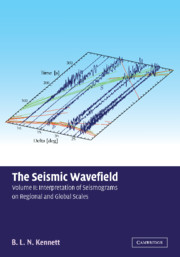Book contents
- Frontmatter
- Contents
- Preface to Volume II
- Part III Local and Regional Events
- Part IV Global Wave Propagation
- Part V The Three-dimensional Earth
- 30 The Influence of Heterogeneity
- 31 Imaging the Earth
- 32 3-D Global Structure
- 33 Mapping the Lithosphere and Upper Mantle
- Appendix Paths and Travel times
- Bibliography
- Index
31 - Imaging the Earth
from Part V - The Three-dimensional Earth
Published online by Cambridge University Press: 31 August 2019
- Frontmatter
- Contents
- Preface to Volume II
- Part III Local and Regional Events
- Part IV Global Wave Propagation
- Part V The Three-dimensional Earth
- 30 The Influence of Heterogeneity
- 31 Imaging the Earth
- 32 3-D Global Structure
- 33 Mapping the Lithosphere and Upper Mantle
- Appendix Paths and Travel times
- Bibliography
- Index
Summary
As we have seen in the previous chapter, it is nowpossible to undertake investigations of the nature of seismic wave propagation in 3-D models. We now turn to the way in which information about such 3-D structures is extracted from seismic observations that provide direct coverage of the region of interest with multiple crossing propagation paths. This process has come to be known as “seismic tomography”. The original meaning of the term tomography implies reconstruction from multiple sections through the feature of interest. Such a configuration occurs in medical applications, where equipment is also designed to provide rather uniform sampling. In studies of the Earth the sampling is much more irregular, being dictated by the location of available sources and receivers. Further, our sensors sit at, or close to, the surface of the Earth so that it is rare to achieve all-round coverage of individual features. As a result we face a situation with somewhat limited sampling and hence significant differences in the potential resolution of different parts of the 3-D structure. The majority of studies have employed fixed grids or basis functions, but in the future we are likely to see increased emphasis on adaptive inversion schemes designed to exploit the characteristics of individual data sets.
Elements of seismic tomography
Seismic tomography depends on the presence of contrast in seismic properties. Such differences in three-dimensional structure are reflected directly in the times of arrival of seismic phases or through the shape and amplitude of seismic waveforms.
The normal procedure is to examine the departures of the observed properties of the seismic wavefield from the predictions for a reference model. In most cases the significant quantity is a time shift in the arrival of a phase, which can be measured directly for a short-period body wave, by correlation techniques for long-period body waves and surface waves, or by waveform inversion where the record contains a number of arrivals as, e.g., the shear wavefield containing both body wave and surface wave components. The travel-time residuals for body waves or modified dispersion characteristics for surface waves can then be used as the basis for recovering a three-dimensional model.
- Type
- Chapter
- Information
- The Seismic WavefieldVolume II: Interpretation of Seismograms on Regional and Global Scales, pp. 426 - 438Publisher: Cambridge University PressPrint publication year: 2002



